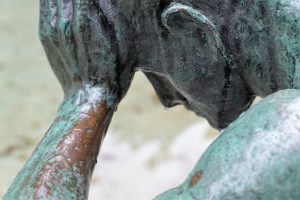Indian tradition roots back too far in history. With passing time, more excavation, more research and little more effort into finding the true knowledge has resulted in unfolding the stories of our origination into mutifolds. One such extravagant and stupendous example is “The Pashupati Seal”
The seal resorted back into its full glory now is an archaeological artifact discovered in the ancient Indus Valley civilization. Found at the Mohenjo-daro site, it dates back to around 2500 BCE, it looks like that which must have been used for stamping on cloth like material mostly – possibly as a block printing material.
The seal features a figure seated in a yogic position, surrounded by various animals. The central figure is identified as a deity and is referred to as the figure of Lord Shiva, who is also known as Pashupati, meaning “Lord of Animals.” The presumed Pashupatinath figurine (an early form of Lord Shiva), is seated cross-legged with an erect posture. The hands hold objects that some interpret as symbols of ritual significance.
Another bone chilling discovery states that the yogic position the presumed figure of Pashupatinath is seated in is Mulabandasana. Which can also known as the Root Lock Pose, is a yoga pose that involves engaging and strengthening the muscles around the pelvic floor, particularly the area known as the “mula bandha” or root lock. An extremely advanced position of yoga, visible performing by the presumed figurine.
Mulabandasana is often incorporated into various yoga practices nowadays, and it’s believed to help channel energy and promote a sense of grounding and stability. It’s essential to practice with awareness and avoid straining any muscles though.
Here’s how you can perform Mulabandasana:
1. Sit comfortably on the floor in a cross-legged position (Padmasana or Sukhasana).
2. Place your hands on your knees.
3. Take a deep breath in.
4. As you exhale, engage your pelvic floor muscles by lifting and contracting the muscles around the perineum (the area between the anus and genitals). This is the mula bandha.
5. Hold this contraction for the duration of your exhalation.
6. Release the lock as you inhale.
7. Repeat this process several times, coordinating the root lock with your breath.
In conclusion, the Pashupati Seal stands as a captivating archaeological artifact from the ancient Indus Valley civilization, the extraordinary seal that features a yogic or meditative posture, surrounded by symbolic elements. While commonly identified as an early representation of the deity Pashupati, associated with Lord Shiva, interpretations of the seal’s exact significance and the nature of the depicted deity remain subjects of scholarly debate. Though the Pashupati Seal provides a glimpse into the cultural and religious practices of the ancient Indus Valley people, yet its true meaning continues to be a fascinating and evolving aspect of archaeological discourse.



